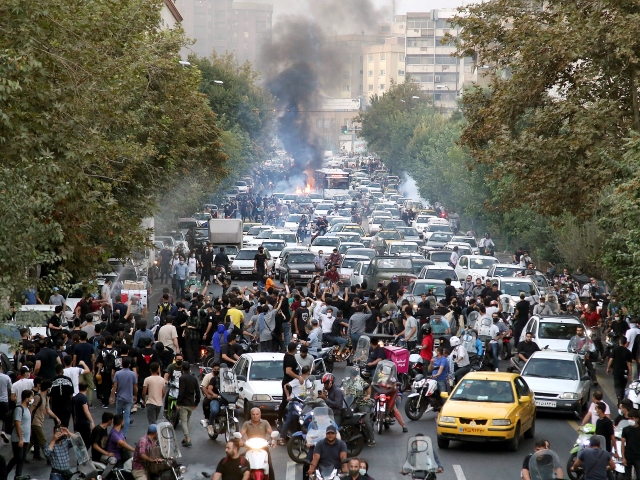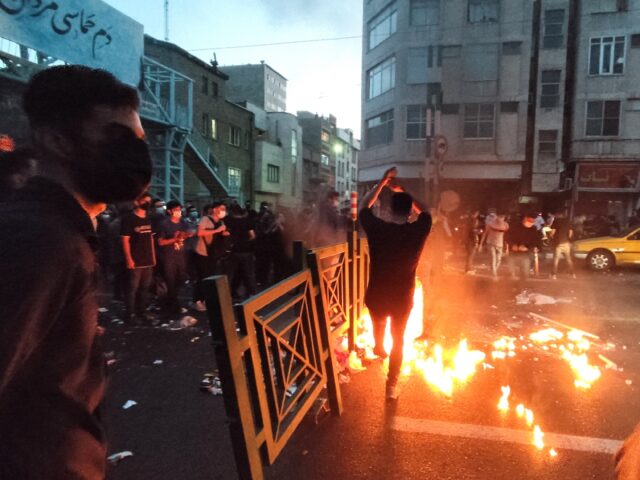Protests continued across Iran on Sunday night despite promises by the regime to “deal decisively with those who oppose the country’s security and tranquility” and take “decisive action without leniency.”
Those warnings came from Iranian President Ebrahim Raisi on Saturday and judiciary chief Gholamhossein Mohseni-Ejei on Sunday, respectively.
The opposition National Council of Resistance of Iran (NCRI) said protests continued “despite the security forces’ onslaught and brutal repression,” with marches in major cities across the country, including the capital city of Tehran:
On the evening of September 25, in Tehran, at least in 10 districts, including Narmak, Sadeghieh, Hafthauz, Ekbatan, Sattar Khan, and Shariati Highway, rebellious youth confronted a large number of Revolutionary guards and forced them to flee. Demonstrators chanted, “Death to Khamenei, death to the dictator,” “Death to Basiji, have no fear, we are all together,” “Noble Iranians, support, support,” and “We will fight, we will die, and we will take back Iran.”
In Shariati Street in Tehran, a large propaganda billboard of the regime and a motorcycle of the repressive forces were set on fire by the rebellious youth. In Narmak, the rebellious youth set fire to two motorbikes and a vehicle of the repressive forces. In Poonak, Pardis, and Ekbatan districts, people continue to protest despite the heavy presence of the repressive forces. In Tehran, the students at the University of Tehran protested on campus and chanted, “We will fight, we will die, and we will take back Iran.” In Sattar Khan, the demonstrators chant, “I will kill whoever killed my sister.”
In Tabriz, in their night demonstrations, the rebellious youths chanted, “No to Shah, no to Mullahs, People, People.” To prevent demonstrations in Karaj, the regime’s agents cut off the electricity in many areas of the city, but the youths continued their protests.
“Death to Khamenei” refers to the theocratic Supreme Leader of Iran, Ayatollah Ali Khamenei. The Basij is a brutal militia controlled by the theocratic wing of the Iranian military, the Islamic Revolutionary Guard Corps (IRGC). It is frequently deployed to violently suppress protests and other perceived threats to the regime.
The chant of “I will kill whoever killed my sister” refers to the cause of the current uprising, the killing of a young Kurdish woman named Mahsa Amini by Iran’s thuggish “morality police” because she was not wearing her headscarf properly.
The number of people killed in the protests after ten days is difficult to determine, in part because the regime has been shutting down Internet service in a bid to prevent dissidents from organizing. The official death toll stands at 41, but international human rights groups believe the total is much higher.
A growing number of foreign governments and organizations are denouncing Iran’s crackdown on protesters, most recently including European Union (EU) foreign policy chief Josep Borrell, who on Sunday called on Iran to halt its “unjustifiable and unacceptable” use of force against demonstrators, restore “the free flow of information,” and thoroughly investigate the death of Mahsa Amini.
“Furthermore, we expect Iran to clarify the number of deaths and arrested, release all non-violent protesters, and provide due process to all detainees,” Borrell said.

Protesters chant slogans during a protest over the death of a woman who was detained by the morality police, in downtown Tehran, Iran, Sept. 21, 2022. (AP Photo, File)
Canadian Prime Minister Justin Trudeau announced sanctions on those responsible for the death of Amini on Monday. The U.S. Treasury Department imposed similar sanctions on Thursday.
“We’ve seen Iran disregarding human rights time and time again, now we see it with the death of Mahsa Amini and the crackdown on protests,” Trudeau said.
The Iranian regime retorted angrily on Monday that Western powers are supporting “rioters” and orchestrating protests in a bid to destabilize the Islamic Republic.
“Washington is always trying to weaken Iran’s stability and security although it has been unsuccessful,” complained Iranian Foreign Ministry spokesman Nasser Kanaani.
Iran on Sunday summoned the British ambassador to complain about the “hostile character” of coverage of the protests from Persian language media headquartered in London. The British Foreign Ministry defended media freedom and condemned Iran’s “crackdown on protesters, journalists, and Internet freedom.”
Iran also summoned the Norwegian ambassador to complain about the “interventionist stance” taken by the Iranian-born speaker of the Norwegian parliament, Masud Gharahkani.
“If my parents had not made the choice to flee in 1987, I would have been one of those fighting in the streets with my life on the line,” Gharahkani said on Sunday.
Protests spread around the world over the weekend, with violence erupting in the streets outside the Iranian embassy in London on Sunday. Another protest march on the Iranian embassy in Paris was met by police in riot gear.
Amnesty International (AI) on Saturday said it has compiled evidence of a “harrowing pattern of Iranian security forces deliberately and unlawfully firing live ammunition at protesters,” including “photos and videos showing deceased victims with horrifying wounds in their heads, chests and stomachs.”
“U.N. member states must go beyond toothless statements, hear the cries for justice from victims and human rights defenders in Iran, and urgently set up an independent U.N. investigative mechanism,” urged AI Middle East and North Africa director Heba Morayef.
On Monday, Khaama Press reported one of the demonstrators killed in the crackdown was 20-year-old Hadis Najafi, who captured international attention last week by confronting police with her hair completely uncovered.
Khaama Press quoted Iranian journalists who said Najafi was killed last Wednesday by attempting to join a protest in the provincial capital of Karaj. Although she was shot several times in the face and neck by Iranian security forces, leaving her face “severely disfigured,” her father was instructed by the authorities to say she died of “natural causes” as a condition of claiming her body.

COMMENTS
Please let us know if you're having issues with commenting.